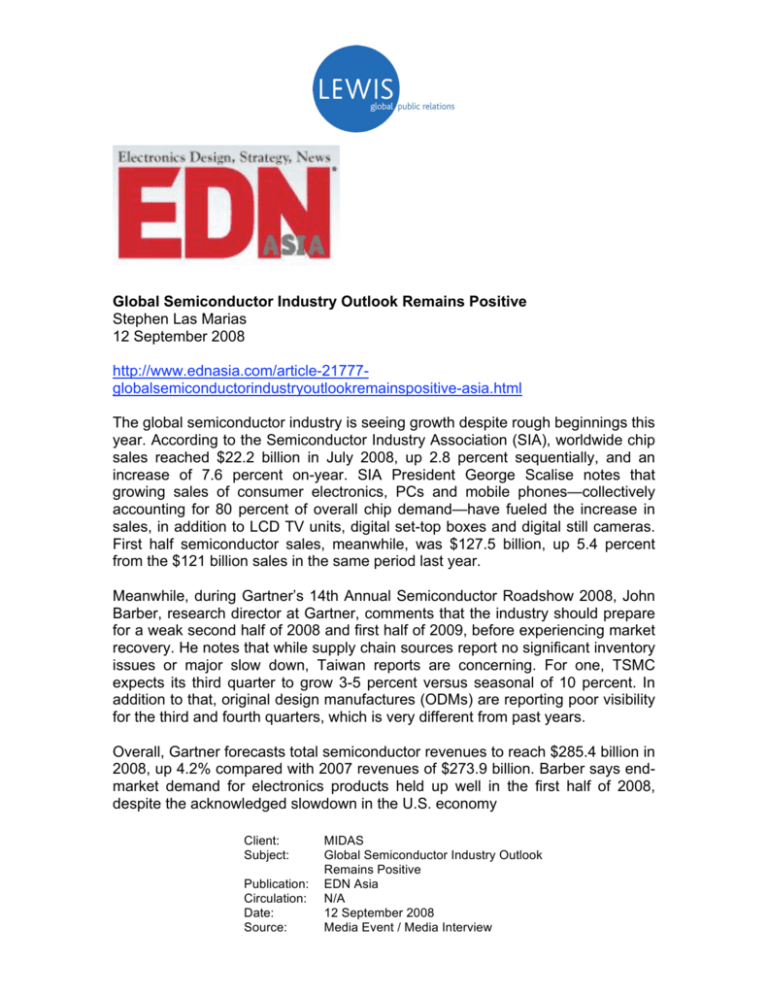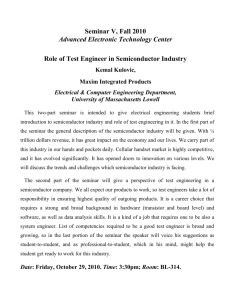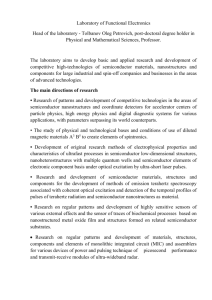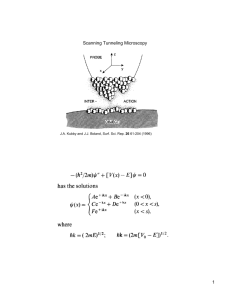EDNAsia-Global - Singapore Semiconductor Industry Association
advertisement

Global Semiconductor Industry Outlook Remains Positive Stephen Las Marias 12 September 2008 http://www.ednasia.com/article-21777globalsemiconductorindustryoutlookremainspositive-asia.html The global semiconductor industry is seeing growth despite rough beginnings this year. According to the Semiconductor Industry Association (SIA), worldwide chip sales reached $22.2 billion in July 2008, up 2.8 percent sequentially, and an increase of 7.6 percent on-year. SIA President George Scalise notes that growing sales of consumer electronics, PCs and mobile phones—collectively accounting for 80 percent of overall chip demand—have fueled the increase in sales, in addition to LCD TV units, digital set-top boxes and digital still cameras. First half semiconductor sales, meanwhile, was $127.5 billion, up 5.4 percent from the $121 billion sales in the same period last year. Meanwhile, during Gartner’s 14th Annual Semiconductor Roadshow 2008, John Barber, research director at Gartner, comments that the industry should prepare for a weak second half of 2008 and first half of 2009, before experiencing market recovery. He notes that while supply chain sources report no significant inventory issues or major slow down, Taiwan reports are concerning. For one, TSMC expects its third quarter to grow 3-5 percent versus seasonal of 10 percent. In addition to that, original design manufactures (ODMs) are reporting poor visibility for the third and fourth quarters, which is very different from past years. Overall, Gartner forecasts total semiconductor revenues to reach $285.4 billion in 2008, up 4.2% compared with 2007 revenues of $273.9 billion. Barber says endmarket demand for electronics products held up well in the first half of 2008, despite the acknowledged slowdown in the U.S. economy Client: Subject: Publication: Circulation: Date: Source: MIDAS Global Semiconductor Industry Outlook Remains Positive EDN Asia N/A 12 September 2008 Media Event / Media Interview India leads Asia’s semiconductor growth The Asia-Pacific region’s semiconductor revenues are expected to reach $159.5 billion in 2008, growing 6.4 percent from $150 billion in the previous year. By 2012, this figure is forecast to grow to $203.3 billion, with a compound annual growth rate 6.3 percent, and accounting for 58.3 percent of the global market, according to Gartner. The region is outpacing global growth. Frost & Sullivan expects Asia to further increase its dominance in the semiconductor industry. The market research firm forecasts the region’s contribution to the global industry revenues to reach 65 to 70 percent by 2010 or 2011. Sanjay Singh, Vice President, Industrial Technologies, Frost & Sullivan Asia Pacific, says the current scenario presents companies with opportunities to strengthen their plans for growth through acquisitions or tie-ups especially in the back-end value chain, testing and packaging-related activities in the region. According to Gartner, China will continue to account for the majority of the total Asia-Pacific market. The country’s market share is forecast to increase to 62 percent in 2012, up from 59 percent in 2007. China is also expected to account for 36 percent of the overall worldwide semiconductor industry in 2012 from 32.7 percent in 2007. However, China’s electronic manufacturing industry growth rate has been slowing down since 2006, according to Gartner. It is India and the “other AsiaPacific” markets that are leading the Asia-Pacific region in terms of growth. According to Phillip Koh, Gartner's Research Vice President, Semiconductors, Asia-Pacific, the rapidly growing domestic demand and strong support from the government are making India the fastest growing semiconductor market worldwide, with a forecast compound annual growth rate of 19 percent from 2007 to 2012 (Figure 1). He notes that overall electronics demand in the region is growing faster than local production, and that overall semiconductor consumption is growing faster than electronics demand. ! Page 2 SOURCE: Gartner Figure 1: India is forecast to become the fastest growing semiconductor market worldwide. Semiconductor manufacturing though is still weak in India—restricted to devices such as discretes, analog IC and optical components; and with the country just having slightly more than 200 very small discrete manufacturers and no operational wafer fab. Nevertheless, the region boasts a strong pool of qualified semiconductor design engineers, with over 100 PCB and equipment design vendors. In fact, Koh notes that the region will account for nearly 25 percent of global semiconductor design services revenues in 2008, with $1.7 billion. The “other Asia-Pacific markets” that Gartner termed include Indonesia, the Philippines, Thailand and Vietnam. Of these markets, Vietnam is said to have the highest CAGR at 46.8 percent within the 2007 to 2012 period. Said to be the next strong growth market in the Asia-Pacific region, Vietnam is forecast to reach revenues of $6.6 billion in 2012 from $1 billion in 2007, mainly driven by ! Page 3 increased electronics investments from EMS companies Hon Hai, Compal, and Quanta. Singapore’s semiconductor industry to rebound in 2009 Singapore is losing manufacturing operations to low-cost regions including China, Malaysia, and Vietnam. Gartner, in fact, forecasts Singapore to have a -8 percent CAGR from 2007 to 2012. On the other hand, the semiconductor industry in the country is upbeat of the market. According to the Microelectronics IC Design and System Association (MIDAS), Singapore’s semiconductor industry association, 2009 will be a year of growth. In a survey conducted by MIDAS, almost 70 percent of the respondents—leading semiconductor players as well as members of MIDAS—are confident of increasing their revenues next year. During MIDAS’ Semicon Summit 2008, Ulf Schneider, MIDAS President and Vice President, Development Centre, of Infineon Technologies Asia-Pacific Pte Ltd said that industry sentiment is looking forward to a strong bounce back next year. Highlighting the Summit’s theme “Leveraging on the Singapore Semiconductor Eco-system”, Schneider explains in an interview that Singapore has a strong workforce and a unique cultural mix of population providing an inspiring and creative atmosphere required for high-profile R&D. “Besides having worldrenowned infrastructure for communications and transport, there are soft factors like its legal system, standard-of-living, health and security, which are essential for IP protection and provide the framework to attract international experts and management. These factors have made possible today’s vertically integrated ecosystem with players from IDMs, foundries, and design houses.” Schneider goes on to say that each country has its own strengths and profiles. Singapore’s structure today is based on the complete value chain from IC design through wafer manufacturing through assembly and test, with a strong focus on high complex systems such as SoCs and devices making use of the innovation and optimization potential across the whole value chain. Singapore has 40 IC design houses, 14 operating silicon wafer fabs, seven MEMS/compound fabs, and 20 assembly and test companies. It is the home to four of the world’s top 10 fabless IC design companies, the world’s top three wafer foundry companies, and the world’s top three sub-contract assembly-and-test companies. Its leadership in hard disk drive and hard disk media output volumes has earned Singapore the confidence of the world’s top five storage and EMS companies that have set up operations in Singapore ranging from design to value-added manufacturing. ! Page 4



